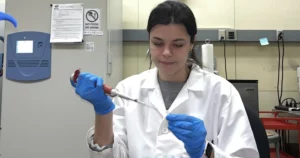Chronic fatigue syndrome is not well understood, though the Centers for Disease Control estimates that up to 2.5 million Americans are living with CFS. The syndrome is characterized by “post-exercise malaise,” or extreme fatigue after a person does any strenuous – or even not-so-strenuous – physical activity.
“I worked with a woman who was diagnosed with this, and hers was so bad that after even simply moving around the house or going upstairs, she would be exhausted and laying in bed the rest of the day,” said Molly Drosen, a biochemistry major at UWM. “It can be very extreme. You might be tired for two whole days from running on the treadmill for 15 minutes.”
Other symptoms include pain, dizziness, cognitive impairment, and orthostatic intolerance.
What causes chronic fatigue syndrome? Good question. Drosen is glad you asked.
Drosen is an undergraduate researcher conducting studies into the genetic origins of CFS under the guidance of Dr. Avik Roy, a researcher with the Simmaron Research Institute. SRI is a nonprofit research organization that collaborates with the Milwaukee Institute of Drug Discovery at UWM.
Scientists have suspected that a genetic component may play a role in CFS – specifically, a gene called ATG13. Earlier research has found that this particular gene is inactive in many people who have been diagnosed with chronic fatigue syndrome. But to test whether ATG13 indeed plays a role in the condition, researchers need a lab rat – or rather, lab mice.
“If they were able to make a mouse where (researchers) knocked out this gene, would the symptoms that we’ve seen with people who are diagnosed with this illness (be seen) in the mouse?” Drosen said.
It was her job to find out. Drosen received a cage of mice from the University of California-Davis that had been specifically bred to have inactive ATG13 genes. Simmaron bred the male and female mouse to create a mouse population with inactive genes, though Drosen had to genotype each mouse to double-check that the gene was actually “switched off.”

After confirming their genetic makeup, it was time to give the mice some exercise.
“That includes putting them on a treadmill where they’re running for 15 minutes, and then we’re looking at open field assessments where they’re in a box and can move around. We also look at muscle waves,” Drosen said.
Muscle waves are involuntary twitches in the muscle, detected in much the same manner as an EKG reads electrical activity in a patient’s heart.
“In a mouse who is not sick, we’re hoping to see flat muscle waves,” Drosen explained. “But when you see mice that are sick, we see repeated fluctuation of muscle waves, and that’s showing that the mouse has muscle weakness.”
Drosen ran her experiments and recorded the results. She found that the mice showed fatigue after completing their treadmill exercise and exhibited symptoms of anxiety in their open field tests in much the same way that people with chronic fatigue syndrome do. She recorded abnormal muscle waves in the mice after exertion.
Her results indicate that ATG13 is very likely a factor in the cause of chronic fatigue syndrome.
“It’s interesting to see how you’re taking this mouse, you’re knocking out this gene, you’re seeing these symptoms, and then you’re looking at a human who also has this gene that is inactive, and you’re seeing very similar symptoms for them,” Drosen said.
But this doesn’t mean that she or other scientists have determined the exact cause of CFS. The ATG13 gene is involved in several metabolic pathways in the body, and any one of those could play a role in causing chronic fatigue syndrome. More research is needed to pinpoint what about this gene triggers this condition.
But this research is a hopeful step in the right direction, said Drosen. She, her mentor, and fellow researchers are completing a paper outlining their findings that they hope to submit for publication in a medical journal in the coming months. Drosen is excited to contribute to the body of research on CSF, but she’s also thrilled just to have her name on a scientific paper as an undergraduate student.
“When you Google my name, that paper will come up. I think about future employers being able to see that,” she said with a smile. “It’s a once-in-a-lifetime opportunity to be an undergraduate student and have that experience.”
Drosen, who has loved science since her high school chemistry classes, isn’t sure what’s next. She’s considering attending a PhD program to pursue more clinical research, but she’s also thinking about becoming a physician assistant, or attending pharmacy school. She plans to graduate this spring and then take a gap year to consider the possibilities for her future.
Wherever she decides to do, she’s already made an impact for people living with chronic fatigue syndrome.
By Sarah Vickery, College of Letters & Science
